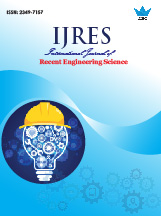Performance Comparison of Deep Learning Techniques in Naira Classification
 |
International Journal of Recent Engineering Science (IJRES) |  |
| © 2024 by IJRES Journal | ||
| Volume-11 Issue-5 |
||
| Year of Publication : 2024 | ||
| Authors : Ismail Ismail Tijjani, Ahmad Abubakar Mustapha, Isma'il Tijjani Idris |
||
| DOI : 10.14445/23497157/IJRES-V11I5P113 |
How to Cite?
Ismail Ismail Tijjani, Ahmad Abubakar Mustapha, Isma'il Tijjani Idris, "Performance Comparison of Deep Learning Techniques in Naira Classification," International Journal of Recent Engineering Science, vol. 11, no. 5, pp. 131-139, 2024. Crossref, https://doi.org/10.14445/23497157/IJRES-V11I5P113
Abstract
The Naira is Nigeria's official currency in daily transactions. This study presents the deployment and evaluation of Deep Learning (DL) models to classify Currency Notes (Naira) by denomination. Using a diverse dataset of 1,808 images of Naira notes captured under different conditions, trained the models employing different architectures and got the highest accuracy with MobileNetV2, the model achieved a high accuracy rate of in training of 90.75% and validation accuracy of 87.04% in classification tasks and demonstrated substantial performance across various scenarios. This model holds significant potential for practical applications, including automated cash handling systems, sorting systems, and assistive technology for the visually impaired. The results demonstrate how the model could boost the Nigerian economy's security and efficiency of financial transactions.
Keywords
Convolutional neural network, Counterfeit notes, Currency classification, Deep learning techniques, Naira classification.
Reference
[1] E. Ogbuju et al., “Deep Learning for Genuine Naira Banknotes,” FUOYE Journal of Pure and Applied Sciences, vol. 5, no. 1, pp. 1-12, 2020.
[Google Scholar] [Publisher Link]
[2] Luca Bionducci et al., On the Cusp of the Next Payments Era: Future Opportunities for Banks, McKinsey & Company, 2023. [Online]. Available: https://www.mckinsey.com/industries/financial-services/our-insights/the-2023-mckinsey-global-payments-report
[3] Jianxin Wu, “Introduction to Convolutional Neural Networks,” National Key Lab for Novel Software Technology, Nanjing University, China, vol. 5, no. 23, pp. 1-31, 2017.
[Google Scholar] [Publisher Link]
[4] Suyash Mahesh Bahrani, “Deep Learning Approach for Indian Currency Classification,” International Journal of Engineering Applied Sciences and Technology, vol. 5, no. 6, pp. 335-340, 2020.
[Google Scholar] [Publisher Link]
[5] K. Shyam Sunder Reddy et al., “An Automated System for Indian Currency Classification and Detection using CNN,” E3S Web of Conferences, vol. 430, pp. 1-9, 2023.
[CrossRef] [Google Scholar] [Publisher Link]
[6] Debabrata Swain et al., “A Deep Learning Framework for the Classification of Brazilian Coins,” IEEE Access, vol. 11, pp. 109448 109461, 2023.
[CrossRef] [Google Scholar] [Publisher Link]
[7] Ritvik Muttreja et al., “Indian Currency Classification and Counterfeit Detection Using Deep Learning and Image Processing Approach,” Advanced Machine Intelligence and Signal Processing, pp. 801-813, 2022.
[CrossRef] [Google Scholar] [Publisher Link]
[8] Allah Bux Sargano, Muhammad Sarfraz, and NuhmanUl Haq, “An Intelligent System for Paper Currency Recognition with Robust Features,” Journal of Intelligent & Fuzzy Systems, vol. 27, no. 4, pp. 1905-1913, 2014.
[CrossRef] [Google Scholar] [Publisher Link]
[9] Junfang Guo, Yanyun Zhao, and Anni Cai, “A Reliable Method for Paper Currency Recognition based on LBP,” 2010 2nd IEEE International Conference on Network Infrastructure and Digital Content, Beijing, China, pp. 359-363, 2010.
[CrossRef] [Google Scholar] [Publisher Link]
[10] Sivadi Balakrishna, and Ahmad Abubakar Mustapha, “Progress in Multi-object Detection Models: A Comprehensive Survey,” Multimedia Tools and Applications, vol. 82, pp. 22405-22439, 2023.
[CrossRef] [Google Scholar] [Publisher Link]
[11] Ahmad Abubakar Mustapha, and Mohamed Sirajudeen Yoosuf, “Exploring the Efficacy and Comparative Analysis of One-stage Object Detectors for Computer Vision: A Review,” Multimedia Tools and Applications, vol. 83, pp. 59143-59168, 2024.
[CrossRef] [Google Scholar] [Publisher Link]
[12] Alex Krizhevsky, Ilya Sutskever, and Geoffrey E. Hinton, “Imagenet Classification with Deep Convolutional Neural Networks,” Advances in Neural Information Processing Systems 25, 2012.
[Google Scholar] [Publisher Link]
[13] Moradeyo Adebanjo Otitoju et al., “Cashless Policy and Naira Redesign of the Central Bank of Nigeria (CBN): A Review,” Journal of Global Economics and Business, vol. 4, no. 14, pp. 45-59, 2023.
[CrossRef] [Google Scholar] [Publisher Link]
[14] Mingxing Tan, and Quoc Le, “EfficientNet: Rethinking Model Scaling for Convolutional Neural Networks,” Proceedings of the 36th International Conference on Machine Learning, vol. 97, pp. 6105-6114, 2019.
[Google Scholar] [Publisher Link]
[15] Christian Szegedy et al., “Rethinking the Inception Architecture for Computer Vision,” 2016 IEEE Conference on Computer Vision and Pattern Recognition (CVPR), Las Vegas, NV, USA, pp. 2818-2826, 2016.
[CrossRef] [Google Scholar] [Publisher Link]
[16] Mark Sandler et al., “Mobilenetv2: Inverted Residuals and Linear Bottlenecks,” Proceedings of the IEEE Conference on Computer Vision and Pattern Recognition, pp. 4510-4520, 2018.
[Google Scholar] [Publisher Link]
[17] Kaiming He et al., “Deep Residual Learning for Image Recognition,” 2016 IEEE Conference on Computer Vision and Pattern Recognition (CVPR), Las Vegas, NV, USA, pp. 770-778, 2016.
[CrossRef] [Google Scholar] [Publisher Link]
[18] Karen Simonyan, and Andrew Zisserman, “Very Deep Convolutional Networks for Large-scale Image Recognition,” arXiv, pp. 1-14, 2014.
[CrossRef] [Google Scholar] [Publisher Link]
[19] Francis Jesmar P. Montalbo, and Alvin S. Alon, “Empirical Analysis of a Fine-tuned Deep Convolutional Model in Classifying and Detecting Malaria Parasites from Blood Smears,” KSII Transactions on Internet and Information Systems, vol. 15, no. 1, pp. 147-165, 2021.
[CrossRef] [Google Scholar] [Publisher Link]
[20] Orlando Iparraguirre-Villanueva et al., “Convolutional Neural Networks with Transfer Learning for Pneumonia Detection,” International Journal of Advanced Computer Science and Applications, vol. 13, no. 9, pp. 1-8, 2022.
[CrossRef] [Google Scholar] [Publisher Link]
[21] Dhananjay Theckedath, and R.R. Sedamkar, “Detecting Affect States using VGG16, ResNet50 and SE-ResNet50 Networks,” SN Computer Science, vol. 1, 2020.
[CrossRef] [Google Scholar] [Publisher Link]
